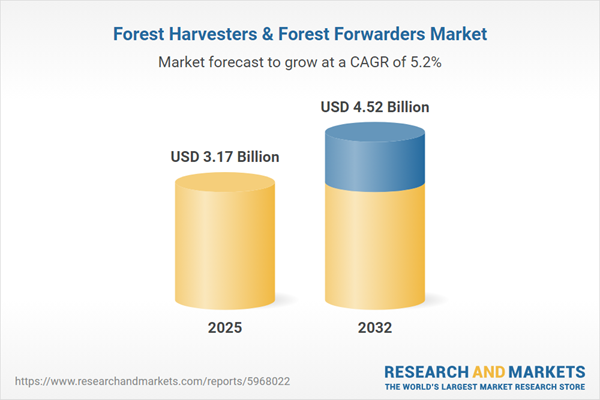Speak directly to the analyst to clarify any post sales queries you may have.
Senior decision-makers in the forest harvesters and forwarders market are navigating a period of profound transformation, driven by digital advancements, regulatory complexity, and the pursuit of sustainable practices. Responsive leadership that champions innovation and strategic adaptation is essential for continued success.
Market Snapshot: Forest Harvesters and Forwarders Market Growth
The forest harvesters and forwarders market is demonstrating consistent expansion, with a projected value of USD 3.17 billion in 2025 up from USD 3.02 billion in 2024, reflecting a compound annual growth rate of 5.18%. This upward trajectory is fueled by evolving regulatory landscapes and strengthened sustainability initiatives across regions. Industry leaders increasingly leverage digital technologies and next-generation equipment to improve efficiency, regulatory alignment, and operational agility. These modernization efforts, spanning equipment design and management processes, empower organizations to respond effectively to shifting project demands while maintaining competitiveness and adhering to industry benchmarks.
Scope & Segmentation
- Equipment Type: Current harvesters and forwarders address a wide spectrum of forestry needs, supporting everything from large-scale timber extraction to targeted urban forestry and specialized selective projects. This segment enables versatility for diverse operational requirements.
- Power Output: Equipment options span from compact, precise models suitable for delicate contexts to high-output machines designed for demanding, high-volume applications—offering modularity for multiple use cases.
- Drive Type: Tracked units deliver strong stability for tough landscapes, while wheeled equipment provides added maneuverability and reduced soil compaction, supporting operational efficiency across different site conditions.
- Application Scope: Advanced machinery underpins not only commercial harvesting but also supports sustainable forestry, conservation, and urban management initiatives, aiding organizations as regulatory and societal expectations increase.
- Distribution Channel: Original equipment manufacturers supply new machinery, with robust aftermarket services extending equipment lifespan and reducing downtime, thus maximizing value throughout the product lifecycle.
- Regional Coverage: North America and Europe lead in technology adoption and compliance, while Asia-Pacific, Middle East, and Africa regions are experiencing dynamic growth catalyzed by infrastructure development and emerging modernization trends.
- Company Profiles: Industry participants like Ponsse Oyj, Deere & Company, Komatsu Ltd., and Tigercat Industries Inc. are integrating digital enhancements and sustainability-focused innovation to address evolving market priorities.
Key Takeaways: Strategic Insights for Senior Leaders
- Implementation of telematics and predictive analytics is advancing maintenance strategies, leading to improved equipment reliability and enhanced operator safety within forestry operations.
- Hybrid drive systems and advanced hydraulics are supporting measurable progress on sustainability and energy efficiency goals across both standard and unique applications.
- Procurement and supplier management are increasingly focused on fostering resilient regional supply chains to adapt to regulatory changes and potential disruptions.
- Expanding machine fleets with a range of equipment types allows organizations to respond flexibly to various project types, including conservation and urban forestry tasks.
- Collaborative industry efforts are propelling the adoption of autonomous technologies, streamlining asset management, and supporting more robust governance frameworks.
- Growth in regional supplier networks enables organizations to more efficiently deploy new technologies and meet expanding compliance requirements.
Tariff Impact: Navigating Policy-Driven Supply Shifts
Changes in United States trade policies are prompting market stakeholders to reassess sourcing and procurement processes for essential forest harvester components. Strengthening ties with regional suppliers and maintaining adaptable inventory strategies help secure supply chain continuity and advance sustainability objectives. These responses have notable implications for operations in North America and neighboring regions.
Methodology & Data Sources
This analysis is based on executive interviews, comprehensive secondary research, and proven assessment models. Ongoing review of automation and emissions reduction ensures continued relevance as technology adoption and environmental standards evolve within the forest harvesters and forwarders market.
Why This Report Matters
- Provides actionable insights for leveraging innovative technologies and advancing sustainable forestry operations.
- Supports leadership in navigating shifting regulatory environments and complex supply chains, enabling robust procurement and risk management strategies.
- Delivers detailed segmentation covering technology, applications, and regional trends for strategic planning and investment decisions.
Conclusion
Positioning your organization for success requires an active focus on digital adoption, sustainability, and industry collaboration. This report equips senior leaders with the targeted insights needed to drive effective decision-making in a rapidly advancing sector.
Additional Product Information:
- Purchase of this report includes 1 year online access with quarterly updates.
- This report can be updated on request. Please contact our Customer Experience team using the Ask a Question widget on our website.
Table of Contents
3. Executive Summary
4. Market Overview
7. Cumulative Impact of Artificial Intelligence 2025
Companies Mentioned
The companies profiled in this Forest Harvesters & Forest Forwarders market report include:- Ponsse Oyj
- Deere & Company
- Komatsu Ltd.
- Tigercat Industries Inc.
- Rottne Industri AB
- Eco Log AB
- Logset Oy
- Kesla Oyj
- HSM Forestry Equipment GmbH
- Harvestec Srl
Table Information
| Report Attribute | Details |
|---|---|
| No. of Pages | 197 |
| Published | October 2025 |
| Forecast Period | 2025 - 2032 |
| Estimated Market Value ( USD | $ 3.17 Billion |
| Forecasted Market Value ( USD | $ 4.52 Billion |
| Compound Annual Growth Rate | 5.1% |
| Regions Covered | Global |
| No. of Companies Mentioned | 11 |









